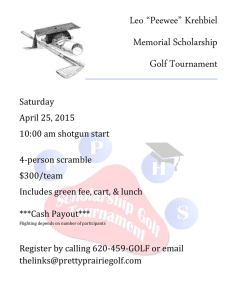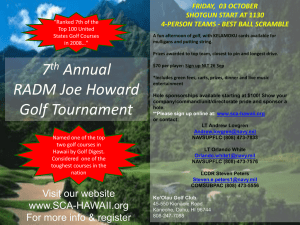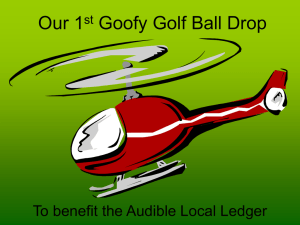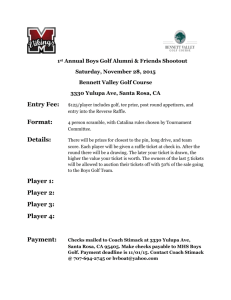SNAG Research Document
advertisement
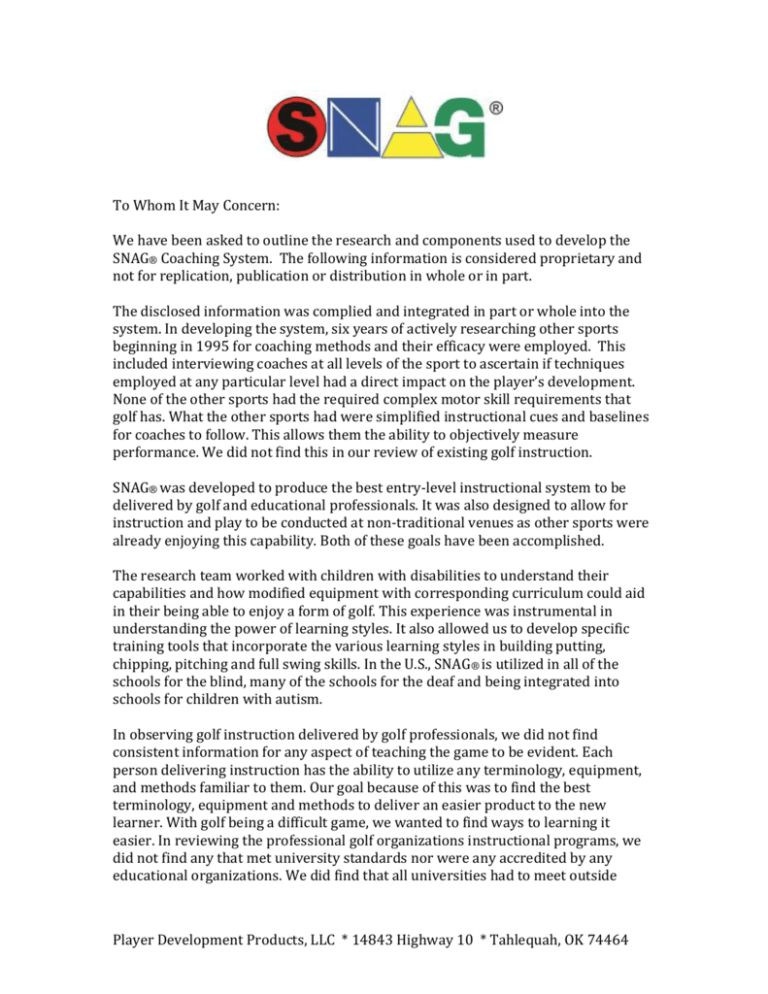
To Whom It May Concern: We have been asked to outline the research and components used to develop the SNAG® Coaching System. The following information is considered proprietary and not for replication, publication or distribution in whole or in part. The disclosed information was complied and integrated in part or whole into the system. In developing the system, six years of actively researching other sports beginning in 1995 for coaching methods and their efficacy were employed. This included interviewing coaches at all levels of the sport to ascertain if techniques employed at any particular level had a direct impact on the player’s development. None of the other sports had the required complex motor skill requirements that golf has. What the other sports had were simplified instructional cues and baselines for coaches to follow. This allows them the ability to objectively measure performance. We did not find this in our review of existing golf instruction. SNAG® was developed to produce the best entry-level instructional system to be delivered by golf and educational professionals. It was also designed to allow for instruction and play to be conducted at non-traditional venues as other sports were already enjoying this capability. Both of these goals have been accomplished. The research team worked with children with disabilities to understand their capabilities and how modified equipment with corresponding curriculum could aid in their being able to enjoy a form of golf. This experience was instrumental in understanding the power of learning styles. It also allowed us to develop specific training tools that incorporate the various learning styles in building putting, chipping, pitching and full swing skills. In the U.S., SNAG® is utilized in all of the schools for the blind, many of the schools for the deaf and being integrated into schools for children with autism. In observing golf instruction delivered by golf professionals, we did not find consistent information for any aspect of teaching the game to be evident. Each person delivering instruction has the ability to utilize any terminology, equipment, and methods familiar to them. Our goal because of this was to find the best terminology, equipment and methods to deliver an easier product to the new learner. With golf being a difficult game, we wanted to find ways to learning it easier. In reviewing the professional golf organizations instructional programs, we did not find any that met university standards nor were any accredited by any educational organizations. We did find that all universities had to meet outside Player Development Products, LLC * 14843 Highway 10 * Tahlequah, OK 74464 accreditation to remain viable. Our goal was to then utilize the university system in finding the best components to achieve our goals. For golf to have an effective feeder system, we had to begin with children. To reach the masses we had to target where children congregate; schools. In understanding how curriculum is developed and delivered in schools we had to meet national standards that were developed for physical education for all physical educators. It also meant that methods would need to be developed to teach large number of children in small spaces in a safe manner. We did not find any golf professional group to have developed any programming that could be effective in this environment. This was a daunting task as we were golf professionals without adequate training to meet these needs. We sought out educational professionals at the university level expert in particular disciplines. This was necessary to achieve our goals in making an easy replicatable system to teach new learners to golf. First, we had to learn how humans learn any subject matter. Second, we had to develop equipment and specific golf programming to implement the learning techniques our education system employs. Third, we had to make it fun. We also had to identify the fields of science we intended to employ to help us realize our intended outcomes. Chromopsychology- The study of how color affects performance. This was essential for us to eliminate fear in the learning process. The equipment was developed with appropriate color combinations for both striking and putting skills as well as our targets. Neurolinguistic Programming – The study of how language affects learning. We reviewed the common language used in golf instruction and its efficacy. We found that there was better and easier language for the new learner to understand the various stroke and swing concepts. As an example: Downswing implies that there is an upswing. The subconscious effect is for the new learner to pick the club up as they swing away from the ball. We developed specific language that paints a better picture for the new learner. Example: We launch the ball depicting expected ball flight. In common golf instruction the new learner would hit the ball, creating confusion. Hit has too many connotations. Learning Styles- We studied the four learning styles, visual, auditory, kinesthetic and tactile. When a person develops their preferences and how we could incorporate this knowledge into training tools specific to teaching the various strokes and swings. We consulted famed learning style specialist Dr. Sue Ellen Read head of one of the 23 global learning style institutes. We are currently the only sports specific curriculum that incorporates learning styles. Player Development Products, LLC * 14843 Highway 10 * Tahlequah, OK 74464 Proprioception- The study of internal and external receptors that allow humans to move without conscious effort. This scientific discipline was essential in understanding how any human movement is achieved. We identified the necessary motor skills to execute the various strokes and swings and matched corresponding word cues to allow the new learner to create repetitive actions. This is essentially how muscle memory would be created. Vestibular System- The vestibular system is the center of our balance. Located in the inner ear, it regulates how we balance ourselves for various tasks. We utilized this research to achieve balance and weight distribution techniques for the new learners learning the full swing. We found substantial faults in new learners emanating from poor balance executing this swing. We also researched the martial arts world and how they develop balance techniques. Equipment Development- The equipment was designed from the ground up starting with the ball. It is 45 grams, the same weight as a traditional golf ball although substantially larger. It is perimeter weighted to give it a beach ball effect and stay on top of imperfect grassed areas. The grips on the clubs are five-sided to fit securely in both hands eliminating torque found in round grips. The top two panels are colored in red and yellow for easy thumb placement. The associated cues allow instructors to teach a proper hold in less than 30 seconds. The size and weight of the clubs are age appropriate and have expanded area for ball contact. This is essential for new learners that are developing their skills. Targets were developed to allow for positive feedback. The bullseye design was implemented to assist the new learner in developing their eyes for targeting skills. Kits and curriculum were designed to teach large groups making an instructors time more valuable. We have been conducting a 10-year study at Northeastern State University in Tahlequah, Oklahoma. The scope of this study was to determine the efficacy of our methods. Our subjects are university students in a physical education program that are learning to play golf with the SNAG® Coaching System. These future physical educators are then tasked to teach school children how to play golf employing the same methods they learned from in a school environment. We have also enlisted noted physical education professors with an early childhood development specialty to assist us in developing our youth programs. Dr. Robert Pangrazi was essential in helping us develop our G-Ball program that targets 5-6 year olds. He has authored over 50 text books relating to physical education. This program was piloted in 15 cities and 2,000 children with the National Recreation and Parks Association (NRPA) in 2011 and 2012. Dr. Pangrazi was also the lead academic behind the successful USTA’s Quick Start program. Tennis has brought in over 4 million new players utilizing this program. Because of the success of G-Ball in our parks, Jack Nicklaus selected SNAG® to be his programming partner for the Jack Nicklaus Learning Leagues along with the NRPA. We are expecting this program alone to reach millions of children globally. Our skills Player Development Products, LLC * 14843 Highway 10 * Tahlequah, OK 74464 acquisition programming is utilized in the First Tee program affecting 6,000 primary schools. Globally, SNAG® is engaged in 10,000+ schools and more than 5,000 golf facilities. We believe that our programming is essential to any professional teaching golf especially those in apprentice programs. Player Development Products, LLC * 14843 Highway 10 * Tahlequah, OK 74464


